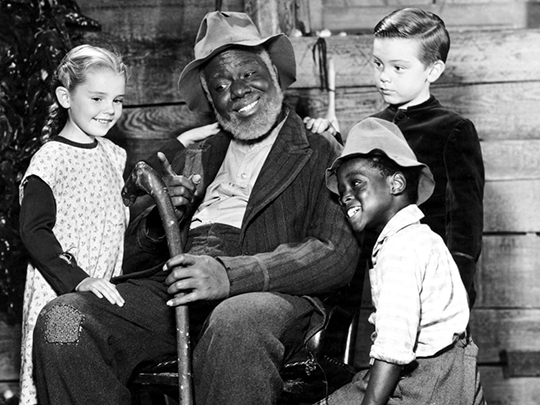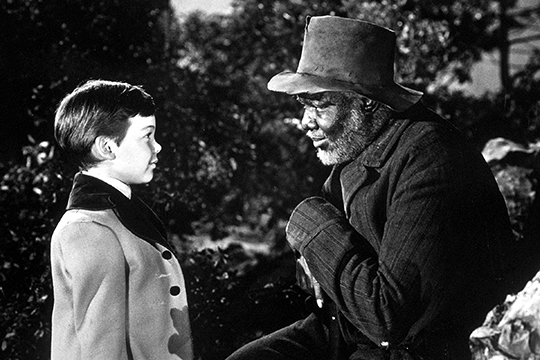What’s It About
Song of the South is a landmark yet deeply problematic Disney production that combines live-action and animation to adapt Joel Chandler Harris’s “Uncle Remus” stories. Directed by Harve Foster and Wilfred Jackson, the film is set in the American South during the Reconstruction era and features James Baskett as Uncle Remus, a formerly enslaved man who shares folk tales about Br’er Rabbit and other animal characters with a young white boy named Johnny (Bobby Driscoll).The film opens with young Johnny arriving at his grandmother’s Georgia plantation with his parents. When Johnny learns his father is returning to Atlanta without the family, he attempts to run away but encounters Uncle Remus, who persuades the boy to return by sharing stories about the adventures of Br’er Rabbit. These storytelling sequences transition into the film’s most technically innovative segments: fully animated tales featuring Br’er Rabbit, Br’er Fox, and Br’er Bear. The signature animated sequence shows Br’er Rabbit tricking his enemies using reverse psychology in the famous “Tar Baby” story, culminating in the iconic song “Zip-a-Dee-Doo-Dah,” which won an Academy Award. Throughout the film, Uncle Remus serves as a surrogate father figure and source of folk wisdom for Johnny, helping him navigate conflicts with local bullies and family tensions. The relationship between Johnny and Uncle Remus forms the emotional core of the film, though this connection is ultimately disrupted when Johnny’s mother forbids him from visiting Uncle Remus, fearing the man’s stories are a bad influence. The film concludes with Johnny injured in an accident, Uncle Remus coming to his aid despite the mother’s prohibition, and a reconciliation that includes animated characters joining the live-action characters in celebration—a technical achievement that predates similar effects in later films like Mary Poppins.



Why It’s Gone
The film presents a sanitized, nostalgic view of plantation life during Reconstruction, portraying Black characters as contented and subservient. While the film never explicitly mentions slavery, its portrayal of race relations in the post-Civil War South creates a misleadingly idyllic picture that minimizes historical oppression. Uncle Remus and other Black characters are portrayed through stereotypical lenses common in mid-century Hollywood. Though James Baskett’s performance earned him an Honorary Academy Award (making him the first Black male performer to receive an Oscar), the character reinforces problematic “magical Negro” tropes where Black characters exist primarily to serve white characters’ development. The exaggerated dialect spoken by the Black characters was criticized even upon the film’s 1946 release by the NAACP and other organizations as perpetuating demeaning stereotypes. As Disney evolved into a global entertainment company promoting inclusive family values, Song of the South became increasingly incompatible with the brand’s image and public positioning. As American society developed more nuanced understandings of slavery’s legacy and representation of Black Americans in media, the film’s problems became more apparent and less excusable as merely “of its time.” Disney has maintained a unique and consistent approach to Song of the South that differs from their handling of other potentially problematic older content. The film received theatrical re-releases in the United States until 1986. It was never released on home video (VHS, DVD, or Blu-ray) in the United States. Limited VHS and LaserDisc releases occurred in European and Asian markets during the 1980s and early 1990s. The last official release was a Japanese LaserDisc in the mid-1990s. Unlike other Disney films with problematic content (such as Dumbo or Peter Pan), which appear on Disney+ with content warnings, Song of the South has been entirely excluded from Disney’s streaming platform. In 2020, Disney CEO Bob Iger explicitly confirmed the film would not be added to Disney+, even with disclaimers. The company has instead repurposed elements of the film that can be separated from its problematic context—the “Zip-a-Dee-Doo-Dah” song appeared in Disney compilations for years (though its usage has decreased recently), and the Splash Mountain ride at Disney theme parks used the animated characters until its 2023 redesign. The film exists today primarily through unauthorized copies circulating online, poor-quality transfers from international LaserDiscs, and bootleg DVDs. Despite its unavailability, clips are used in Disney documentaries about animation techniques, and the animated segments occasionally appear in isolation in Disney retrospectives. Modern evaluation of Song of the South requires balancing its technical achievements with its significant cultural problems. The film pioneered techniques for combining live-action and animation. James Baskett’s performance, while trapped in a problematic role, demonstrates remarkable talent and charisma. The animated sequences, considered independently, showcase Disney animation at its height. The songs, particularly “Zip-a-Dee-Doo-Dah,” remain memorable contributions to the American musical canon. However, these achievements exist within a framework that fundamentally misrepresents a painful chapter of American history and perpetuates harmful stereotypes about Black Americans. Disney’s decision to withhold the film rather than contextualizing it (as they’ve done with other problematic content) reflects both the depth of its issues and the company’s assessment that the film cannot be adequately framed for contemporary audiences. The film’s absence from legitimate distribution channels makes it difficult for scholars, historians, and media students to study this significant chapter in both animation history and the evolution of racial representation in American cinema, raising complex questions about how best to address problematic cultural artifacts while neither erasing history nor perpetuating harm.


